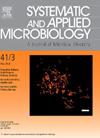新疆Gillisia ensis sp. nov.的基因组特征:氮代谢、胁迫适应和应用潜力的见解
IF 4.2
2区 生物学
Q2 BIOTECHNOLOGY & APPLIED MICROBIOLOGY
引用次数: 0
摘要
高海拔盐湖拥有独特的微生物群落,其特征是对极端环境条件的特殊适应。然而,使细菌在这些栖息地生存和生理功能的潜在机制仍未被探索。本研究从新疆高海拔盐湖阿奇库尔湖沉积物样品中分离到一种新型革兰氏阴性、非运动杆状细菌Q332T。该菌株为兼性好氧菌株,在28°C、pH 7.0和3.0 % (w/v) NaCl条件下生长最佳。过氧化氢酶和氧化酶活性呈阳性。在菌株Q332T中鉴定出的主要脂肪酸包括anteiso- C15:0、anteiso- c17:1、iso- C15:0和C16:0。主要检测呼吸醌为甲基萘醌-6 (MK-6)。极性脂质分析鉴定出磷脂酰乙醇胺(PE)、一种未鉴定的酰基酰磷脂酰甘油(APGL)、三种未鉴定的脂质(L)、三种糖脂质(GL)、一种磷脂质(PL)和四种酰胺脂质(AL)。基因组DNA G + C含量为38.9%。基因组特征揭示了一个多功能的代谢库,包括独特的c1单位代谢途径和全面的氮循环能力,特别是反硝化和同化硝酸盐还原。此外,菌株Q332T显示出强大的逆境适应机制,包括对寒冷和渗透胁迫的耐受性,对氧化应激的防御,以及对重金属的抗性。基于表型、化学分类、系统发育和基因组特征,认为菌株Q332T代表了Gillisia属的一个新种,并建议将其命名为Gillisia xinjiangensis sp. 11。型应变为Q332T (=KCTC 102200T = MCCC 1K09490T)。本文章由计算机程序翻译,如有差异,请以英文原文为准。

Genomic characterization of Gillisia xinjiangensis sp. nov.: insights into nitrogen metabolism, stress adaptation, and application potential
High-altitude saline lakes host distinctive microbial communities characterized by specialized adaptations to extreme environmental conditions. However, the underlying mechanisms enabling bacterial survival and physiological function in these habitats remain largely unexplored. In this study, a novel Gram-stain-negative, non-motile, rod-shaped bacterium, designated strain Q332T, was isolated from sediment samples collected from Achikkul Lake, a high-altitude saline lake in Xinjiang, northwestern China. The strain was facultatively aerobic, and grew optimally at 28 °C, pH 7.0, and 3.0 % (w/v) NaCl. Catalase and oxidase activities were positive. Major fatty acids identified in strain Q332T included anteiso‐C15:0, anteiso-C17:1, iso‐C15:0 and C16:0. The primary respiratory quinone detected was menaquinone-6 (MK-6). Polar lipid analyses identified phosphatidylethanolamine (PE), one unidentified acyloxyacyl phosphatidylglycerol (APGL), three unidentified lipids (L), three glycolipids (GL), one phospholipid (PL), and four amidolipids (AL). The genomic DNA G + C content is 38.9 %. Genomic characterization revealed a versatile metabolic repertoire, including unique C1-unit metabolic pathways and comprehensive nitrogen cycling capabilities, notably denitrification and assimilatory nitrate reduction. Furthermore, strain Q332T displayed robust mechanisms for stress adaptation, encompassing tolerance to cold and osmotic stress, defenses against oxidative stress, and resistance to heavy metals. Based on phenotypic, chemotaxonomic, phylogenetic, and genomic features, strain Q332T is considered to represent a novel species of the genus Gillisia, for which the name Gillisia xinjiangensis sp. nov. is proposed. The type strain is Q332T (=KCTC 102200T = MCCC 1K09490T).
求助全文
通过发布文献求助,成功后即可免费获取论文全文。
去求助
来源期刊

Systematic and applied microbiology
生物-生物工程与应用微生物
CiteScore
7.50
自引率
5.90%
发文量
57
审稿时长
22 days
期刊介绍:
Systematic and Applied Microbiology deals with various aspects of microbial diversity and systematics of prokaryotes. It focuses on Bacteria and Archaea; eukaryotic microorganisms will only be considered in rare cases. The journal perceives a broad understanding of microbial diversity and encourages the submission of manuscripts from the following branches of microbiology:
 求助内容:
求助内容: 应助结果提醒方式:
应助结果提醒方式:


